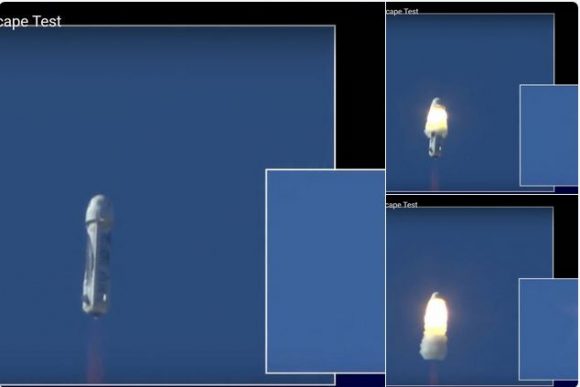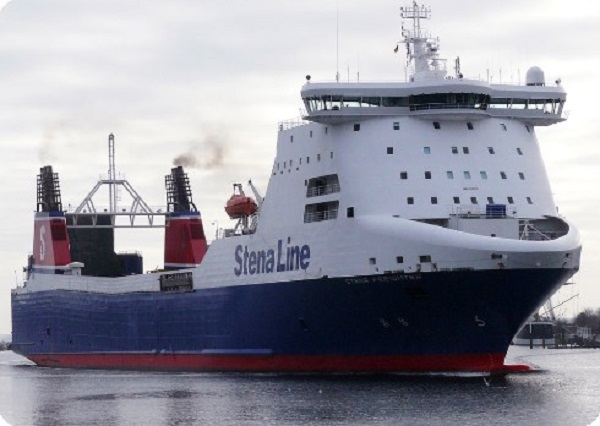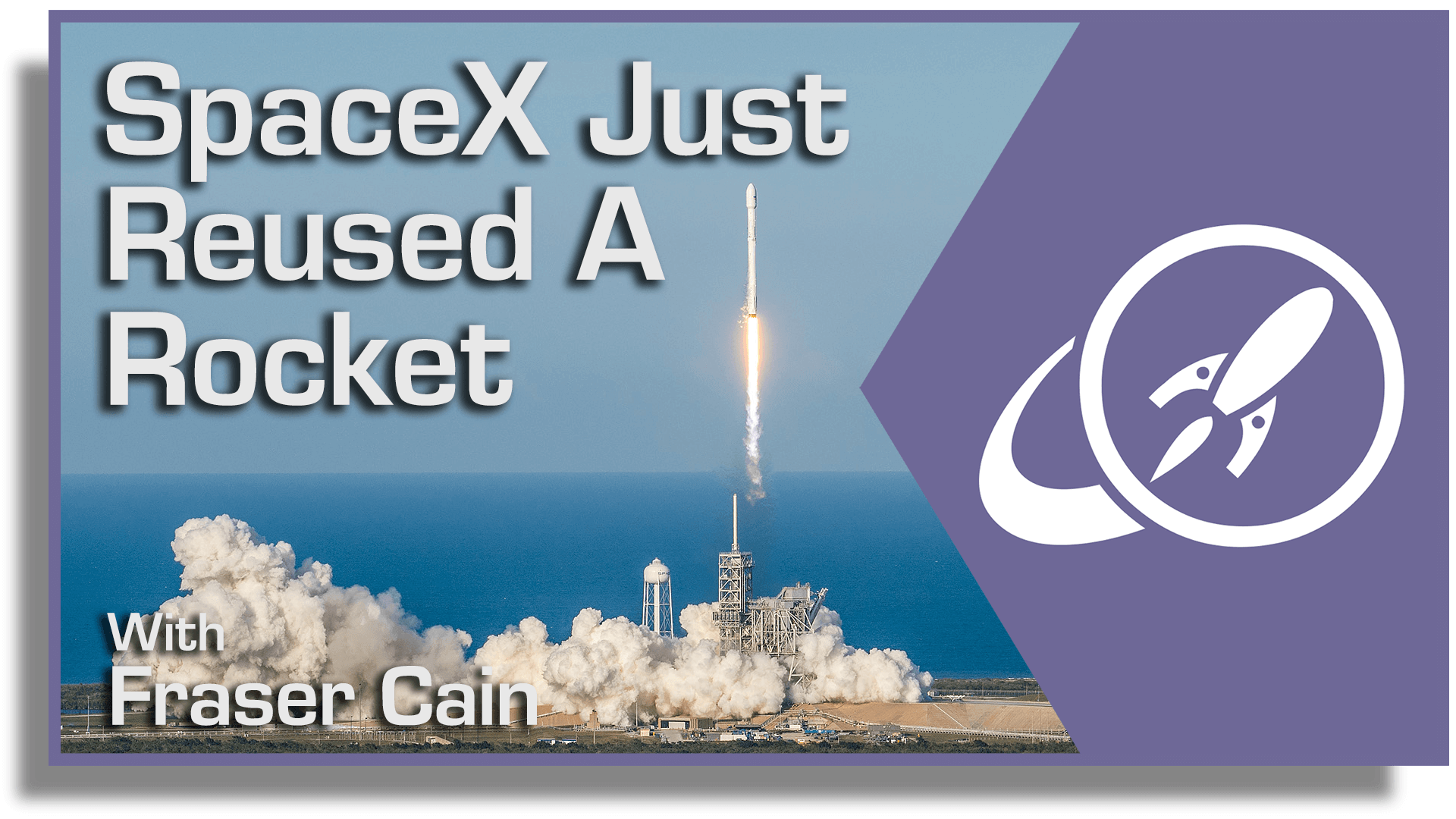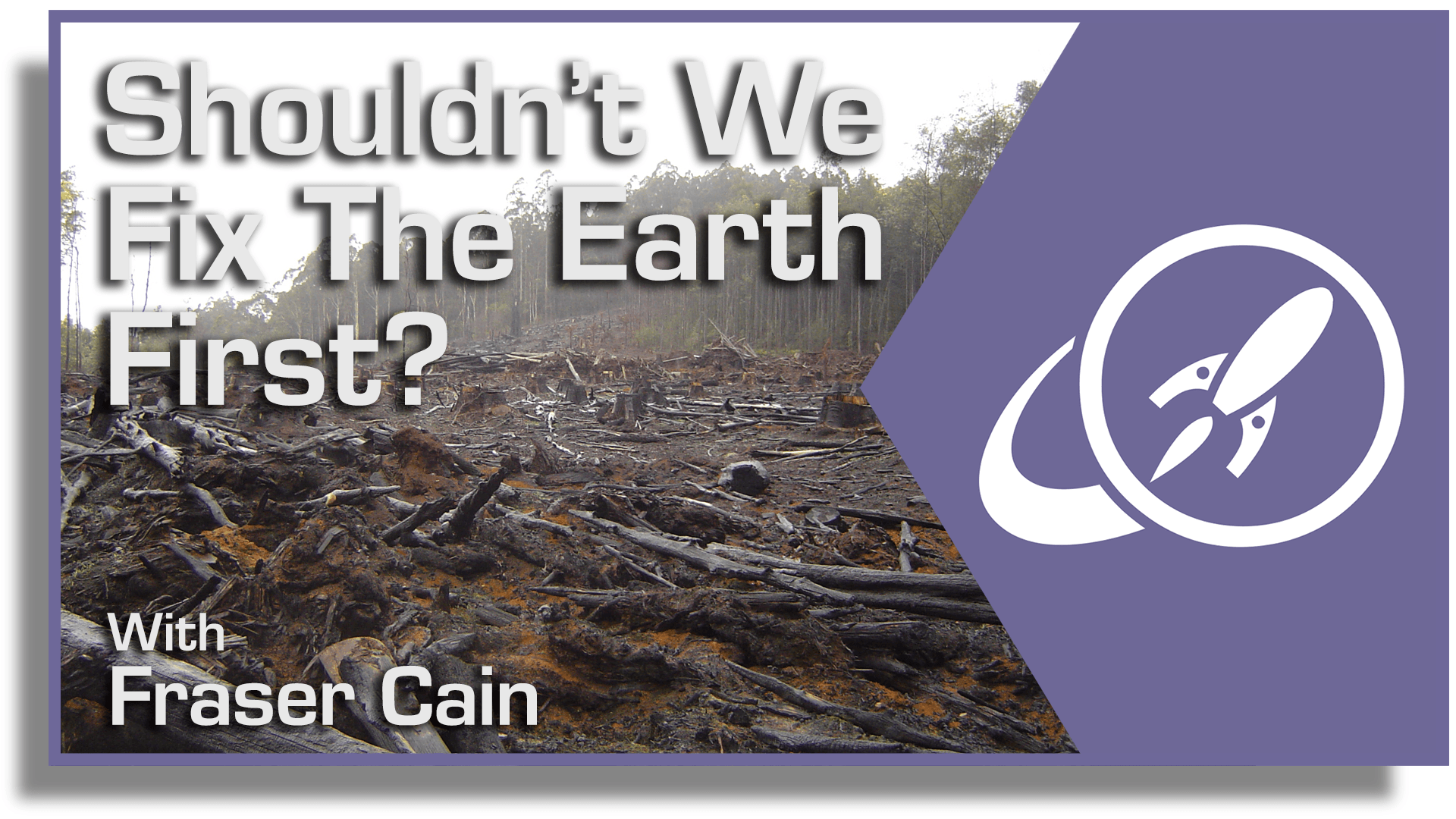Today’s breed of billionaire space entrepreneurs likes to keep us guessing, don’t they? Mr. Elon Musk is famous for announcing partial plans on Twitter, then leaving us to cajole the details out of him. Now, Jim Bezos, Amazon founder and Blue Origin visionary, is making us guess what an upcoming mysterious announcement might mean, all on the tails of another successful flight for New Shepard.
Continue reading “Blue Origin’s New Shepard Flies Again, a Week Before Their Mysterious Announcement”Blue Origin has Shown off a New Video of its New Glenn Rocket Design
Blue Origin, the private aerospace company founded by multi-billionaire (and founder of Amazon) Jeff Bezos, is looking to make its presence felt in the rapidly expanding NewSpace industry. To this end, Blue Origin has spent years developing a fleet of reusable rockets that they hope will someday rival those of their greatest competitor, SpaceX.
So far, these efforts have led to the New Shepard rocket, which can send payloads (and soon, space tourists) to suborbital altitudes. In the coming years, Blue Origin hopes to go farther with their New Glenn rocket, a reusable launch vehicle capable of reaching Low-Earth Orbit (LEO). The company recently released a new video of the New Glenn, which showcased the designs latest features and specifications.
Continue reading “Blue Origin has Shown off a New Video of its New Glenn Rocket Design”Blue Origin will be Landing its Rockets on a Used Cargo Ship. It’ll Get Converted in Time for First Flights in 2021
One of the defining characteristics of the modern space age is the way private aerospace companies (aka. NewSpace) is playing a role like never before. With every passing year, more and more small launch providers are being founded. And between the largest companies – SpaceX and Blue Origin – competition is heating up to see who will secure the most lucrative contracts and make it to Mars first!
In order to ensure they remain competitive, Blue Origin indicated that it would be following SpaceX’s lead by recovering its first-stage rocket boosters at sea. To this end, the company has acquired a used Danish vessel known as Stena Freighter, which recently arrived in Florida. Much like SpaceX’s Autonomous Spaceport Drone Ships (ASDS), this vessel will be used to retrieve spent rockets after they deliver their cargo to space.
Clearly a Fan. Jeff Bezos Himself Announced that Amazon was Picking up The Expanse
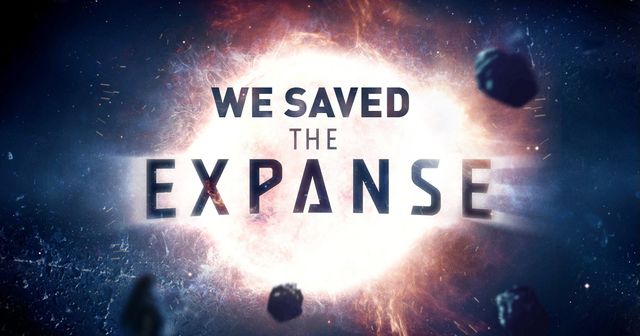
At Comic-Con 2015, fans of space opera and science fiction were treated to their first glimpse of The Expanse, the miniseries adaptation of Daniel Abraham and Ty Franck’s novels. Needless to say, the reaction was magnificent, and is perhaps best up by IO9’s Lauren Davis, who penned a review of the trailer titled, “The Expanse Is the Show We’ve Been Wanting Since Battlestar Galactica.
It was therefore a bit of a blow when recently, the Syfy network announced that the third season (which is currently airing) would be the show’s last. Reaction to the news was swift, prompting fans to mount multiple campaigns to have the show picked up by Netflix, Amazon Prime, or another video streaming service. And on Friday, May 25th, Jeff Bezos (founder of Amazon and Blue Origin) obliged them.
The announcement was made at the National Space Society’s International Space Development Conference in Los Angeles Friday night. Bezos was attending the conference to receive the prestigious Gerard K. O’Neill Memorial Award for Space Settlement Advocacy, thanks to his advancement of commercial space exploration through his company, Blue Origin.
The award was conferred by O’Neill’s widow, Tasha O’Neill. In the midst of laying out his company’s vision for the future of space exploration, which included colonies in space, he announced that the science fiction show was being picked up by Amazon Prime, Amazon’s subscription service that offers access to music, videos and other media. As Bezos said, to general applause:
“I was talking to the cast half an hour ago, before the break for dinner started. I was telling them that we are working hard at Amazon to save The Expanse but it wasn’t a done deal yet. During dinner, ten minutes ago, I just got word that The Expanse is saved. The show is extraordinary and these guys are unbelievably talented.”
The news quickly went viral and fan sites dedicated to getting the show renewed quickly responded. In fact, #SaveTheExpanse.com went so far as to declare victory:
“We did it! Thanks to the incredible, historic efforts of the cast, crew and fans of the critically acclaimed sci-fi epic, “The Expanse,” the television show has been resurrected by Amazon Studios and Alcon Entertainment for a fourth season. Just two weeks after being cancelled by Syfy, the massive grassroots effort that followed the news achieved its goal in saving the series, which is now set to appear on Amazon Prime.”
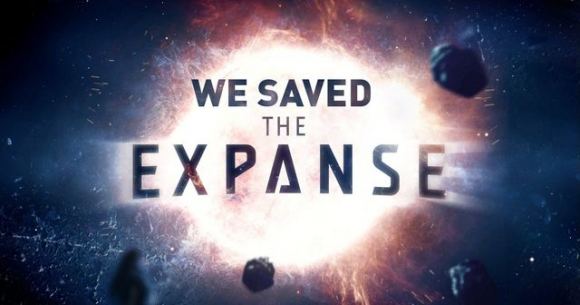
Alcon Entertainment co-founders and co-CEOs Andrew Kosove and Broderick Johnson were also very happy with the fact that their show had been picked up by Amazon Prime. As they were quoted as saying by Variety Magazine:
“We couldn’t be more excited that ‘The Expanse’ is going to continue on Amazon Prime. We are deeply grateful that Jeff Bezos, Jen Salke, and their team at Amazon have shown such faith in our show. We also want to thank Laura Lancaster, head of Alcon Television for her tireless efforts. We are fully aware that this wouldn’t have been possible if it wasn’t for the staggering outpouring of support from the most creative, hardest working sci-fi fans around the world. From reddit campaigns to airplanes, we say thank you. It worked!”
Bezos also took the opportunity to honor Gerard K. O’Neill, a physicist and well-known proponent of space colonization. Among the many ideas he proposed for creating settlements in space, the most-well known is arguably the concept of the O’Neill Cylinder (aka. O’Neill Colony). This would consist of two counter-rotating cylinders in space that would rotate to provide artificial gravity.
Bezos also acknowledged a debt to O’Neill seminal work, The High Frontier: Human Colonies in Space. “Professor O’Neill was very formative for me,” he said. “I read ‘The High Frontier’ in high school. I read it multiple times. And I was already primed. And as soon as I read it, it made sense to me. It seemed very clear that planetary surfaces were not the right place for an expanding civilization inside the solar system.”

On the subject of O’Neill Cylinders, Bezos indicated that they are a good means for creating accessible space habitats. “For one, they’re not that big,” he explained. “There’s another argument I always make too, [which] is, they’re hard to get to. [If] we build our own colonies, we can do them in near-Earth vicinity, because people will want to come back to Earth. Very few people – for a long time, anyway – are going to want to abandon Earth altogether.”
It seems rather fitting that an entrepreneur who is dedicated to making science fiction a reality has chosen to renew a science fiction show. Clearly, Bezos is a fan, or perhaps he knows that fans of shows like The Expanse are also fans of his commercial space efforts. In either case, fans of the series are happy to know that there will be more seasons to come!
Further Reading: Variety, Space.com, savetheexpanse.org
Jeff Bezos Says The New Shepard Will Soar Next on Sunday. Here’s How to Watch It Live.
One of the greatest challenges of modern spaceflight is finding a way to make launching rockets into space commercially viable. Reduced costs will not only mean more launches, but the ability to conduct more ambitious programs in Low Earth Orbit (LEO) and beyond. To this end, many private aerospace companies are investing in reusability, where the first-stages of a rocket and even entire vehicles are retrieved after launch and reused.
In recent years, Elon Musk has become famous for his development of reusable first-stage boosters and fairings. But Blue Origin’s Jeff Bezos has also been no slouch when it comes to making the company’s fleet of rockets reusable. On Sunday, April 29th, the company is passing another milestone with the 8th test flight of the New Shephard rocket, an event which is being live-streamed.
As a fully reusable vertical takeoff, vertical landing (VTVL) space vehicle, the New Shephard is crucial to Blue Origins’ vision of commercial spaceflight and space tourism. Consisting of a pressurized capsule aboard a booster, the combined vehicle launches vertically and accelerates for two and a half minutes before the engine cuts off. The capsule then separates and floats into suborbit while the booster returns to Earth under its own power and with the help of parachutes.
Launch preparations are underway for New Shepard’s 8th test flight, as we continue our progress toward human spaceflight. Currently targeting Sunday 4/29 with launch window opening up at 830am CDT. Livestream info to come. @BlueOrigin #GradatimFerociter pic.twitter.com/zAYpAGWB8C
— Jeff Bezos (@JeffBezos) April 27, 2018
Named in honor of famed astronaut Alan Shepard, the rocket’s crew capsule has room for six people. These will consist of customers looking to take a flight to suborbital altitudes and experience the sensation of weightlessness. As they state on their website:
“The New Shepard capsule’s interior is an ample 530 cubic feet – offering over 10 times the room Alan Shepard had on his Mercury flight. It seats six astronauts and is large enough for you to float freely and turn weightless somersaults.”
The announcement for the 8th test launch came on Friday, April. 27th, when Bezos tweeted that “launch preparations are underway for New Shepard’s 8th test flight, as we continue our progress toward human spaceflight. Currently targeting Sunday 4/29 with launch window opening up at 830am CDT.” The launch would take place at the company’s suborbital launch and engine test site near the town of Van Horn in West Texas.
As with the previous New Shepard test launch, which took place on Dec. 12th, 2017, the crew for this mission would be the mannequin known as “Mannequin Skywalker” (check out the video of this flight below). As with the previous uncrewed flight, Mannequin Skywalker will be testing the capsule’s safety restrains in advance of a crewed test flight.
At 0526 (0826 PST), Bezos tweeted that the flight window – which was originally set for 0845 CDT (0630 PDT) – had been delayed due to thunderstorm over West Texas. At 0950 CDT (0750 PDT), Bezos issued a follow-up tweet that the liftoff target was now 1113 CDT (0913 PST). Live streaming will begin 15 minutes before the launch, which you can watch by going to Blue Origin’s website.
If successful, this launch test will place Blue Origin one step closer to conducting space tourism. As Bob Smith, the CEO of Blue Origin, recently indicated in an interview with CNBC, he hopes the company will begin these launches by the end of this year. In addition, he said that the company continues to pursue the development of engine technology, which it hopes United Launch Alliance will use on its Vulcan rockets as well.
Be sure to check out the live-steam of the launch, and feel free to enjoy this video of the New Shepard conducting a space tourism flight while you’re waiting:
Further Reading: Blue Origin
Pardon My Vomit: Zero G Ettiquette In the Age Of Space Tourism
It’s a new era for space travel. And if there’s one thing that sets it apart from the previous one, it is the spirit of collaboration that exists between space agencies and between the public and private sector. And with commercial aerospace (aka. NewSpace) companies looking to provide everything from launch services to orbital and lunar tourism, a day is fast-approaching when ordinary people will be able to go into space.
Because of this, many aerospace companies are establishing safety and training programs for prospective clients. If civilians plan on going into space, they need to have the benefit of some basic astronaut training. In short, they will need to learn how to go safely conduct themselves in a zero-gravity environment, with everything from how to avoid blowing chunks to how to relieve oneself in a tidy fashion.
In recent years, companies like Blue Origin, Virgin Galactic, Space Adventures, Golden Spike, and SpaceX have all expressed interest in making space accessible to tourists. The proposed ventures range from taking passengers on suborbital spaceflights – a la Virgin Galactic’s SpaceShipTwo – to trips into orbit (or the Moon) aboard a space capsule – a la Blue Origins’ New Shepard launch system.
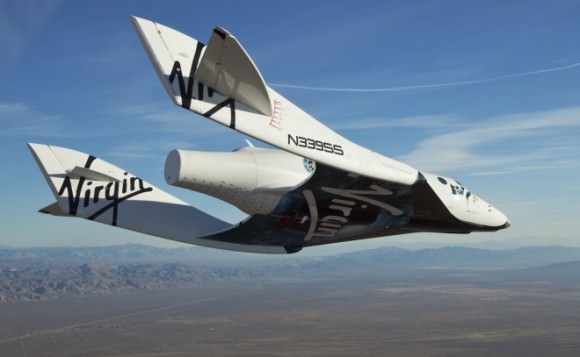
And while these trips will not be cheap – Virgin Galactic estimates that a single seat aboard SpaceShipTwo will cost $250,000 – they absolutely have to be safe! Luckily, space agencies like NASA already have a very well-established and time-honored practice for training astronauts for zero-g. Perhaps the most famous involves flying them around in a Zero-Gravity Aircraft, colloquially known as the “Vomit Comet”.
This training program is really quite straightforward. After bringing astronaut trainees to an altitude of over 10,000 meters (32,000 feet), the plane begins flying in a parabolic arc. This consists of it climbing and falling, over and over, which causes the trainees to experience the feeling of weightlessness whenever the plane is falling. The name “vomit comet” (obviously) arises from the fact that passengers tend to lose their lunch in the process.
The Soviet-era space program also conducted weightlessness training, which Roscomos has continued since the collapse of the Soviet Union. Since 1984, the European Space Agency (ESA) has also conducts parabolic flights using a specially-modified Airbus A300 B2 aircraft. The Canadian Space Agency (CSA) has done the same since it was founded in 1989, relying on the Falcon 20 twin-engine jet.
Given the fact that NASA has been sending astronauts into space for nearly 60 years, they have certainly accrued a lot of experience in dealing with the effects of weightlessness. Over the short-term, these include space adaptation syndrome (SAS), which is also known as “space sickness”. True to its name, the symptoms of SAS include nausea and vomiting, vertigo, headaches, lethargy, and an overall feeling of unease.
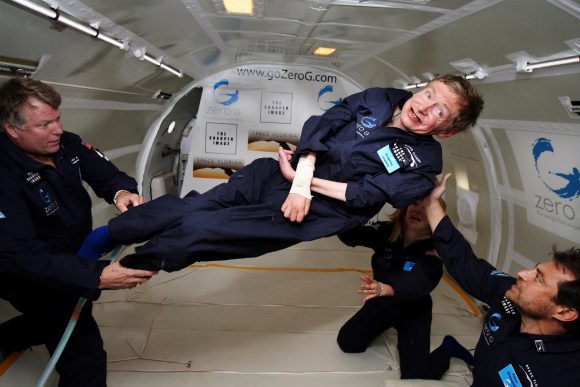
Roughly 45% of all people who have flown in space have suffered from space sickness. The duration of varies, but cases have never been shown to exceed 72 hours, after which the body adapts to the new environment. And with the benefit of training, which includes acclimating to what weightlessness feels like, both the onset and duration can be mitigated.
Beyond NASA and other space agencies, private companies have also offered reduced gravity training to private customers. In 2004, the Zero Gravity Corporation (Zero-G, based in Arlington, Virginia) became the first company in the US to offer parabolic flights using a converted Boeing 727. In 2008, the company was acquired by Space Adventures, another Virginia-based space tourism company.
Much like Virgin Galactic, Space Adventures began offering clients advance bookings for sub-orbital flights, and has since expanded their vision to include lunar spaceflights. As such, the Zero-G experience has become their training platform, allowing clients the ability to experience weightlessness before going into space. In addition, some of the 700 clients who have already booked tickets with Virgin Galactic have used this same training method to prepare.
Similarly, Virgin Galactic is taking steps to prepare its astronauts for the day when they begin making regular flights into sub-orbit. According to the company, this will consist of astronauts taking part in a three day pre-flight preparation program that will be conducted onsite at Spaceport America – Virgin Galactic’s spaceflight facility, located in New Mexico.
Aside from microgravity, their astronaut training will also emphasize how to function when experiencing macrogravity (i.e. multi-g forces), which occur during periods of acceleration. The training will also include medical check-ups, psychological evaluations, and other forms of pre-flight prepation – much in the same way that regular astronauts are prepared for their journey. As they state on their website:
“Pre-flight preparation will ensure that each astronaut is mentally and physically prepared to savor every second of the spaceflight. Basic emergency response training prescribed by our regulators will be at the forefront. Activities to aid familiarity with the spaceflight environment will follow a close second.”
Blue Origin, meanwhile, has also been addressing concerns with regards to its plan to start sending tourists into suborbit in their New Shepard system. After launching from their pad outside of El Paso, Texas, the rocket will fly customers to an altitude of 100 km (62 mi) above the Earth. During this phase, the passengers will experience 3 Gs of acceleration – i.e. three times what they are used to.
Once it reaches space, the capsule will then detach from the rocket. During this time, the passengers will experience a few minutes of weightlessness. Between the intense acceleration and the feeling of freefall, many have wondered if potential clients should be worried about space sickness. These questions have been addressed by former NASA astronaut Nicholas Patrick, who now serves as Blue Origin’s human integration architect.
During an interview with Geekwire in January of 2017, he indicated that they plan to provide barf bags for customers to tuck into their flight suits, just in case. This is similar to what astronauts do aboard the International Space Station (see video above) and during long-term spaceflights. When asked about what customers could do to prepare for space sickness, he also emphasized that some training would be provided:
“It’s a short flight, so we won’t be asking people to train for a year, the way NASA astronauts trained for a shuttle flight, or three years, the way they train for a long space station mission. We’re going to get this training down to a matter of days, or less. That’s because we don’t have very many tasks. You need to know how to get out of your seat gracefully, and back into your seat safely.
“We’ll teach you a few safety procedures, like how to use the fire extinguisher – and maybe how to use the communication system, although that will come naturally to many people. What we’ll probably spend some time on is training people how to enjoy it. What are they going to take with them and use up there? How are they going to play? How are they going to experiment? Not too much training, just enough to have fun.”
“Getting sick to your stomach can be a problem on zero-G airplane flights like NASA’s “Vomit Comet,” but motion sickness typically doesn’t come up until you’ve gone through several rounds of zero-G. Blue Origin’s suborbital space ride lasts only 11 minutes, with a single four-minute dose of weightlessness.”
Bezos also addressed these questions in early April during the 33rd Space Symposium in Colorado Springs, where his company was showcasing the New Shepard crew capsule. Here too, audience members had questions about what passengers should do if they felt the need to vomit (among the other things) in space.
“They don’t throw up right away,” he said, referring to astronauts succumbing to space sickness. “We’re not going to worry about it… It takes about three hours before you start to throw up. It’s a delayed effect. And this journey takes ten or eleven minutes. So you’re going to be fine.”
On April 27th, during a special Q&A session of Twitch Science Week, Universe Today’s own Fraser Cain took part in a panel discussion about the future of space exploration. Among the panelists were and Ariane Cornell, the head of Astronaut Strategy and Sales for Blue Origin. When the subject of training and etiquette came up, she described the compact process Blue Origins intends to implement to prepare customers for their flight:
“[T]he day before flight is when we give you a full – intense, but very fun – day of training. So they are going to teach you all the crucial things that you need. So ingress, how do you get into the capsule, how do you buckle in. Egress, how do you get out of the seat, out of the hatch. We’re going to teach you some emergency procedures, because we want to make sure that you guys are prepared, and feel comfortable. We’re also going to teach you about zero-g etiquette, so then when we’re all up there and we’re doing our somersaults, you know… no Matrix scenes, no Kung Fu fighting – you gotta make sure that everybody gets to enjoy the flight.”
When asked (by Fraser) if people should skip breakfast, she replied:
“No. It’s the most important meal of the day. You’re going to want to have your energy and we’re pretty confident that you’re going to have a good ride and you’re not going to feel nauseous. It’s one parabola. And when we’ve seen people, for example, when they go on rides on NASA’s “Vomit Comet”… What we’ve seen from those types of parabolic flights is that people – if they get sick – its parabola six, seven, eight. It’s a delayed effect, really. We think that with that one parabola – four minutes – you’re going to enjoy every second of it.”
Another interesting issue was addressed during the 33rd Space Symposium was whether or not the New Shepard capsule would have “facilities”. When asked about this, Bezos was similarly optimistic. “Go to the bathroom in advance,” he said, to general laughter. “If you have to pee in 11 minutes, you got problems.” He did admit that with boarding, the entire experience could take up to 41 minutes, but that passengers should be able to wait that long (fingers crossed!)
But in the event of longer flights, bathroom etiquette will need to be an issue. After all, its not exactly easy to relieve oneself in an environment where all things – solid and liquid – float freely and therefore cannot simply be flushed away. Luckily, NASA and other space agencies have us covered there too. Aboard the ISS, where astronauts have to relieve themselves regularly, waste-disposal is handled by “zero-g toilets”.
Similar to what astronauts used aboard the Space Shuttle, a zero-g toilet involves an astronaut fastening themselves to the toilet seat. Rather than using water, the removal of waste is accomplished with a vacuum suction hole. Liquid waste is transferred to the Water Recovery System, where it is converted back into drinking water (that’s right, astronauts drink their own pee… sort of).
Solid waste is collected in individual bags that are stored in an aluminum container, which are then transferred to the docked spacecraft for disposal. Remember that scene in The Martian where Mark Watney collected his crew members solid waste to use as fertilizer? Well, its much the same. Poo in a bag, and then let someone remove it and deal with it once you get home.
When it comes to lunar tourism, space sickness and waste disposal will be a must. And when it comes to Elon Musk’s plan to start ferrying people to Mars in the coming decades – aboard his Interplanetary Transportation System – it will be an absolute must! It will certainly be interesting to see how those who intend to get into the lunar tourism biz, and those who want to colonize Mars, will go about addressing these needs.
In the meantime, keep your eyes on the horizon, keep your barf bags handy, and make sure your zero-g toilet has a tight seal!
Sources:
SpaceX Just Re-Used a Rocket. Why This Changes Everything
On March 30, 2017, SpaceX performed a pretty routine rocket launch. The payload was a communications satellite called SES-10, owned by a company in Luxembourg. And if all goes well, the satellite will eventually make its way to a high orbit of 35,000 km (22,000 miles) and deliver broadcasting and television services to Latin America.
For all intents and purposes, this is an absolutely normal, routine, and maybe even boring event in the space industry. Another chemical rocket blasted off another communications satellite to join the thousands of satellites that have come before.
Of course, as you probably know, this wasn’t a routine launch. It was the first step in one of the most important achievements in space flight – launch reusability. This was the second time the 14-story Falcon 9 rocket had lifted off and pushed a payload into orbit. Not Falcon 9s in general, but this specific rocket was reused.
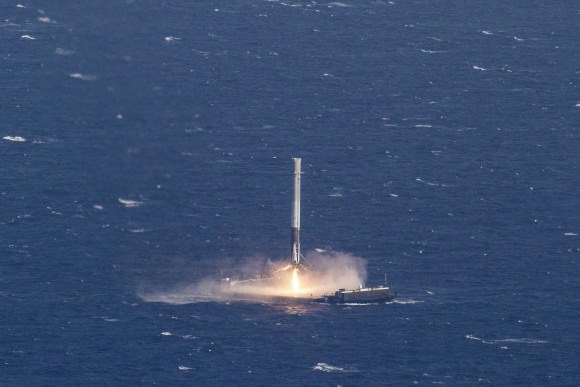
In a previous life, this booster blasted off on April 8, 2016 carrying CRS-8, SpaceX’s 8th resupply mission to the International Space Station. The rocket launched from Florida’s Cape Canaveral, released its payload, re-entered the atmosphere and returned to a floating robotic barge in the Atlantic Ocean called Of Course I Still Love You. That’s a reference to an amazing series of books by Iain M. Banks.
Why is this such an amazing accomplishment? What does the future hold for reusability? And who else is working on this?
Developing a rocket that could be reused has been one of the holy grails of the space industry, and yet, many considered it an engineering accomplishment that could never be achieved. Trust me, people have tried in the past.
Portions of the space shuttle were reused – the orbiter and the solid rocket boosters. And a few decades ago, NASA tried to develop the X-33 as a single stage reusable rocket, but ultimately canceled the program.
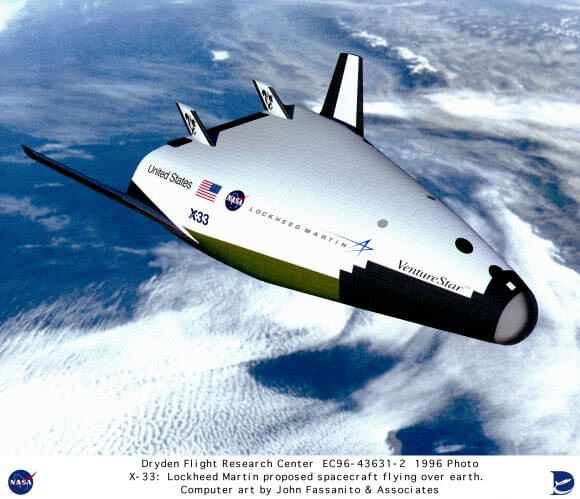
To reuse a rocket makes total sense. It’s not like you throw out your car when you return from a road trip. You don’t destroy your transatlantic airliner when you arrive in Europe. You check it out, do a little maintenance, refuel it, fill it with passengers and then fly it again.
According to SpaceX founder Elon Musk, a brand new Falcon 9 first stage costs about $30 million. If you could perform maintenance, and then refill it with fuel, you’d bring down subsequent launches to a few hundred thousand dollars.
SpaceX is still working out what a “flight-tested” launch will cost on a reused Falcon 9 will cost, but it should turn into a significant discount on SpaceX’s already aggressive prices. If other launch providers think they’re getting undercut today, just wait until SpaceX really gets cranking with these reused rockets.
For most kinds of equipment, you want them to have been re-used many times. Cars need to be taken to the test track, airplanes are flown on many flights before passengers ever climb inside. SpaceX will have an opportunity to test out each rocket many times, figuring out where they fail, and then re-engineering those components. This makes for more durable and safer launch hardware, which I suspect is the actual goal here – safety, not cost.
In addition to the first stage, SpaceX also re-used the satellite fairing. This is the covering that makes the payload more aerodynamic while the rocket moves through the lower atmosphere. The fairing is usually ejected and burns up on re-entry, but SpaceX has figured out how to recover that too, saving a few more million.
SpaceX’s goals are even more ambitious. In addition to the first stage booster and launch fairing, SpaceX is looking to reuse the second stage booster. This is a much more complicated challenge, because the second stage is going much faster and needs to lose a lot more velocity. In late 2014, they put their plans on hold for a second stage reuse.
SpaceX’s next big milestone will be to decrease the reuse time. From almost a year to under 24 hours.
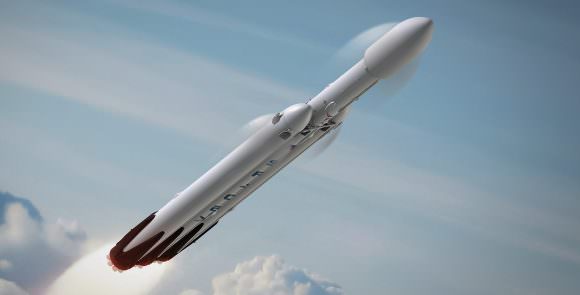
Sometime this year, SpaceX is expected to do the first launch of the Falcon Heavy. A launch system that looks like it’s made up of 3 Falcon-9 rockets bolted together. Since that’s basically what it is.
The center booster is a reinforced Falcon-9, with two additional Falcon-9s as strap-on boosters. Once the Falcon Heavy lifts off, the three boosters will detach and will individually land back on Earth, ready for reassembly and reuse. This system will be capable of carrying 54,000 kilograms into low Earth orbit. In addition, SpaceX is hoping to take the technology one more step and have the upper stage return to Earth.
Imagine it. Three boosters and upper stage and payload fairing all returning to Earth and getting reused.
And waiting in the wings, of course, is SpaceX’s huge Interplanetary Transport System, announced by Elon Musk in September of 2016. The super-heavy lift vehicle will be capable of carrying 300,000 kilograms into low Earth orbit.

For comparison, the Apollo era Saturn V could carry 140,000 kg into low Earth orbit, so this thing will be much much bigger. But unlike the Saturn V, it’ll be capable of returning to Earth, and landing on its launch pad, ready for reuse.
SpaceX just crossed a milestone, but they’re not the only player in this field.
Perhaps the biggest competitor to SpaceX comes from another internet entrepreneur: Amazon’s Jeff Bezos, the 2nd richest man in the world after Bill Gates. Bezos founded his own rocket company, Blue Origin in Seattle, which had been working in relative obscurity for the last decade. But in the last few years, they demonstrated their technology for reusable rocket flight, and laid out their plans for competing with SpaceX.
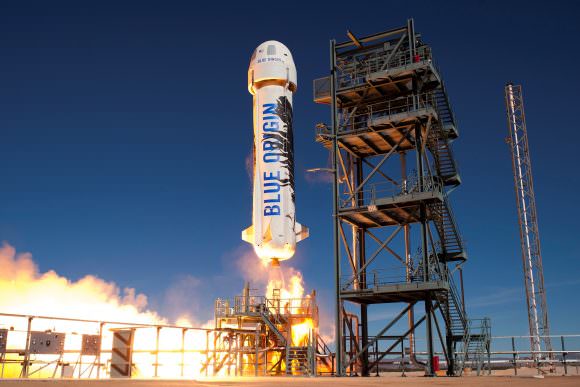
In April 2015, Blue Origin launched their New Shepard rocket on a suborbital trajectory. It went up to an altitude of about 100 km, and then came back down and landed on its launch pad again. It made a second flight in November 2015, a third flight in April 2016, and a fourth flight in June 2016.
That does sound exciting, but keep in mind that reaching 100 km in altitude requires vastly less energy than what the Spacex Falcon 9 requires. Suborbital and orbital are two totally milestones. The New Shepard will be used to carry paying tourists to the edge of space, where they can float around weightlessly in the vomit of the other passengers.
But Blue Origin isn’t done. In September 2016, they announced their plans for the follow-on New Glenn rocket. And this will compete head to head with SpaceX. Scheduled to launch by 2020, like, within 3 years or so, the New Glenn will be an absolute monster, capable of carrying 45,000 kilograms of cargo into low Earth orbit. This will be comparable to SpaceX’s Falcon Heavy or NASA’s Space Launch System.
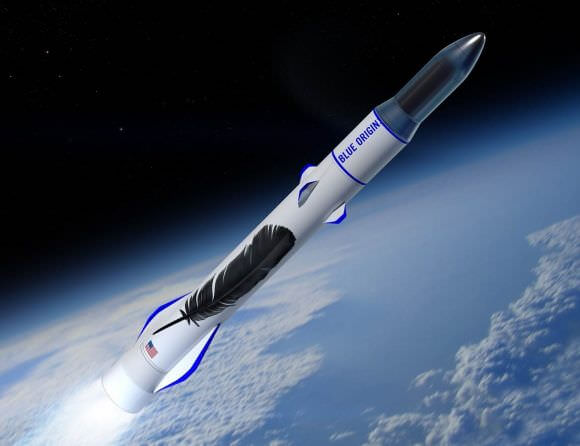
Like the Falcon 9, the New Glenn will return to its launch pad, ready for a planned reuse of 100 flights.
A decade ago, the established United Launch Alliance – a consortium of Boeing and Lockheed-Martin – was firmly in the camp of disposable launch systems, but even they’re coming around to the competition from SpaceX. In 2014, they began an alliance with Blue Origin to develop the Vulcan rocket.
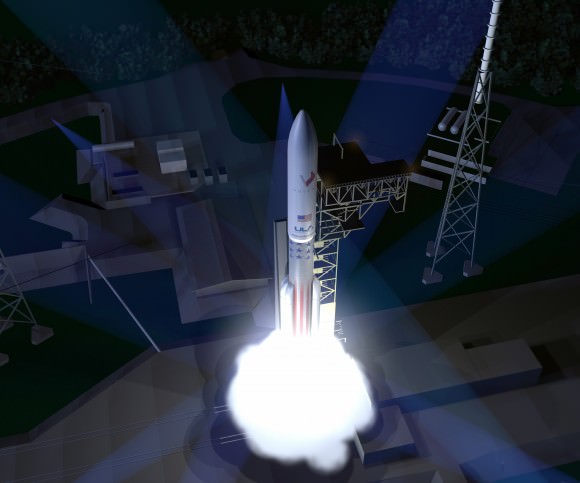
The Vulcan will be more of a traditional rocket, but some of its engines will detach in mid-flight, re-enter the Earth’s atmosphere, deploy parachutes and be recaptured by helicopters as they’re returning to the Earth. Since the engines are the most expensive part of the rocket, this will provide some cost savings.
There’s another level of reusability that’s still in the realm of science fiction: single stage to orbit. That’s where a rocket blasts off, flies to space, returns to Earth, refuels and does it all over again. There are some companies working on this, but it’ll be the topic for another episode.
Now that SpaceX has successfully launched a first stage booster for the second time, this is going to become the new normal. The rocket companies are going to be fine tuning their designs, focusing on efficiency, reliability, and turnaround time.
These changes will bring down the costs of launching payloads to orbit. That’ll mean it’s possible to launch satellites that were too expensive in the past. New scientific platforms, communications systems, and even human flights become more reasonable and commonplace.
Of course, we still need to take everything with a grain of salt. Most of what I talked about is still under development. That said, SpaceX just reused a rocket. They took a rocket that already launched a satellite, and used it to launch another satellite.
It’s a pretty exciting time, and I can’t wait to see what happens next.
Now you know how I feel about this accomplishment, I’d like to hear your thoughts. Do you think we’re at the edge of a whole new era in space exploration, or is this more of the same? Let me know your thoughts in the comments.
Take a Peek Inside Blue Origin’s New Shepard Crew Capsule
Blue Origin founder Jeff Bezos provided a sneak peek today into the interior of the New Shepard crew capsule, the suborbital vehicle for space tourism. He released a few images which illustrate what the flight experience might be like on board.
“Our New Shepard flight test program is focused on demonstrating the performance and robustness of the system,” Bezos said via an email release. “In parallel, we’ve been designing the capsule interior with an eye toward precision engineering, safety, and comfort.”
Take a look:

The interior has six seats with large windows for a great view of our planet.
“Every seat’s a window seat,” Bezos said.
What looks like a console in the center of the capsule is actually the escape motor to protect future passengers from any anomaly during launch. Unlike the Apollo escape system that used an escape “tower” motor located on top of the capsule to ‘pull’ the crew cabin away from a failing booster, New Shepard’s escape system is mounted underneath the capsule, to ‘push’ the capsule away from a potentially exploding booster. Blue Origin successfully tried out this escapes motor in October 2016 during an in-flight test.
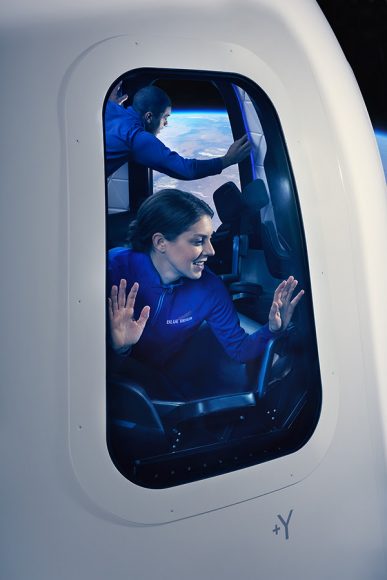
Blue Origin’s suborbital rocket is named after Alan Shepard, the first NASA astronaut to take a suborbital trip to space in 1961. Their orbital rocket will be named New Glenn, named for John Glenn, the first American in orbit. Blue Origin is also developing a larger rocket to bring payloads beyond Earth orbit, and they’ve named that vehicle after Neil Armstrong, the first human to walk on the Moon.
Blue Origin hasn’t released a timeline yet of when they will be flying their first paying passengers; all Bezos has said is that he hopes to fly as soon as possible.
The commercial company describes the experience this way:
Following a thrilling launch, you’ll soar over 100 km above Earth—beyond the internationally recognized edge of space. You’ll help extend the legacy of space explorers who have come before you, while pioneering access to the space frontier for all.
Sitting atop a 60-foot-tall rocket in a capsule designed for six people, you’ll feel the engine ignite and rumble under you as you climb through the atmosphere. Accelerating at more than 3 Gs to faster than Mach 3, you will count yourself as one of the few who have gone these speeds and crossed into space.
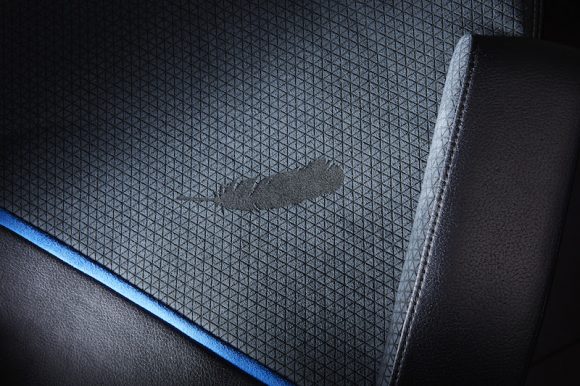
“We are building Blue Origin to seed an enduring human presence in space, to help us move beyond this blue planet that is the origin of all we know,” Bezos said in the press release after a successful test flight of the New Shepard rocket in 2015. “We are pursuing this vision patiently, step-by-step. Our fantastic team in Kent, Van Horn and Cape Canaveral is working hard not just to build space vehicles, but to bring closer the day when millions of people can live and work in space.”
Blue Origin’s black feather logo on the New Shepard rocket is ‘a symbol of the perfection of flight,’ says founder Jeff Bezos, and “flight with grace and power in its functionality and design.”
Their moto, “Gradatim Ferociter” is Latin for “Step by Step, Ferociously.” Bezos has said that is how they are approaching their goals in spaceflight.
Find out more about the Blue Origin “Astronaut Experience” on their website.
If you’re lucky enough to be attending the 33rd Space Symposium in Colorado Springs April 3-6, 2017, you can see the New Shepard capsule for yourself. “The high-fidelity capsule mockup will be on display alongside the New Shepard reusable booster that flew to space and returned five times.” Bezos said.
Shouldn’t We Fix the Earth First?
I seem like a pretty calm and collected guy, but if you want to see me go on an epic rant, all you have to do is ask me some variation on the question: “why should we bother exploring space when we’ve got problems to fix here on Earth.”
I see this question all the time. All the time, in forums, comments on videos, and from people in audiences.
I think the question is ridiculous on many levels, and I’ve got a bunch of reasons why, but allow me to explain them here.
Before I do, however, I want you to understand that I believe that we human beings are indeed messing up the environment. We’re wiping out species faster than any natural disaster in the history of planet Earth. We’re performing a dangerous experiment on the climate of the planet, increasing temperatures worldwide, with devastating consequences, for both ecosystems and human civilization.

Unless we get this under control, and there’s no reason to believe we will, we’re going to raise temperatures to levels unseen in millions of years.
There are islands of plastic garbage in the oceans, collected into huge toxic rafts by the currents. Colonies of bees are dying through pesticides and habitat loss.
We’re even polluting the space around the Earth with debris that might tear apart future space missions.
I believe the science, and the science says we’re making a mess.
The first thing is that this whole question is a false dilemma fallacy. Why do we have to choose between space exploration and saving the planet? Why can’t we do both?
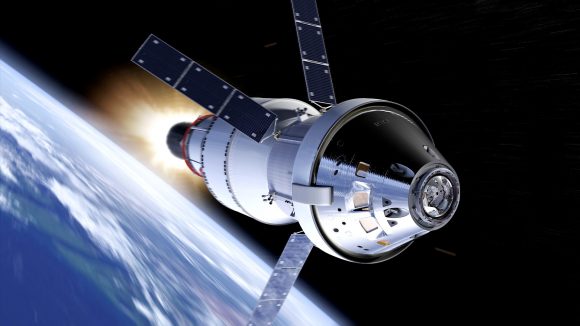
The world spent nearly $750 billion on cigarettes in 2014. NASA’s total budget is less than $20 billion, and Elon Musk thinks he can start sending colonists to Mars for less than $10 billion.
How about the whole world stops smoking, and we spend $20 billion on colonizing Mars and the other $730 billion on renewable fuels and cleaning up our negative impact on the environment, reducing poverty and giving people access to clean water?
Americans spend $27 billion on takeout pizza. Don’t get me wrong, pizza’s great, but I’d be willing to forego pizza if it meant a vibrant and healthy industry of space exploration.
Gambling, lawn care, hood ornaments, weapons of war. Humans spend a lot of money on a lot of things that could be redirected towards both space exploration and reducing our environmental impact.
Number two, it might turn out that space exploration is the best way to save the Earth. I totally agree with Blue Origin’s Jeff Bezos when he says that we already know that Earth is the best place in the Solar System. Let’s keep it that way.
Mars might be a fascinating place to visit and an adventure to colonize, but I want to swim in rivers, climb mountains, walk in forests, watch birds, sail in the ocean.
But the way we’re using up the natural environment will take away from all that. As Bezos says, we should move all the heavy industry off Earth and up into space. Use solar collectors to gather power, mine asteroids for their raw materials. Keep Earth as pristine as possible.
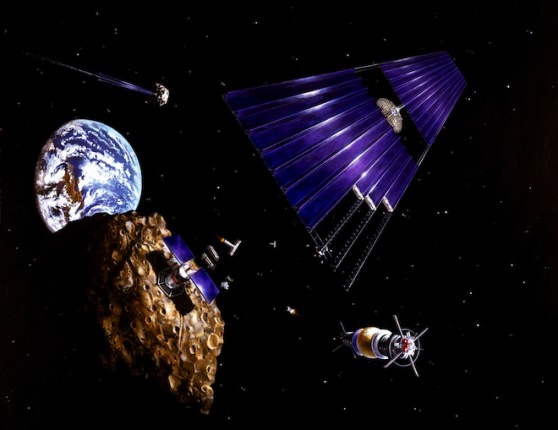
We won’t know how to do that unless we actually go into space and learn how to survive and run that industry, from space.
Number three, it might be that we’ve already crossed the point of no return. There’s a great science fiction story by Spider Robinson called “In the Olden Days”. It’s about how modern society turned its back on technology, and lost the ability to ever recover.
Humanity used up the entire technology ladder that nature put in front of us; the chunks of iron just sitting on the ground, the oil bubbling out of the Earth, the coal that was easily accessible. Now it takes an offshore drilling rig to get at the oil.
These resources took the Earth millions and even billions of years to accumulate for us to use, and transcend. When the cockroaches evolve intelligence and opposable thumbs, they won’t have those easily accessible resources to jumpstart their own space exploration program.
Number four, as Elon Musk says, we have to protect the cradle of consciousness. Until we find proof otherwise, we have to assume that the Earth is the only place in the Universe that evolved intelligent life.
And until the alien overlords show up and say, “don’t worry humans, we’ve got this,” we have to assume that the responsibility for seeding the life with intelligence rests on us. And we’re one asteroid strike or nuclear apocalypse away from snuffing that out.
I don’t entirely agree that Mars is the best place to do it, but we should at least have another party going on somewhere.
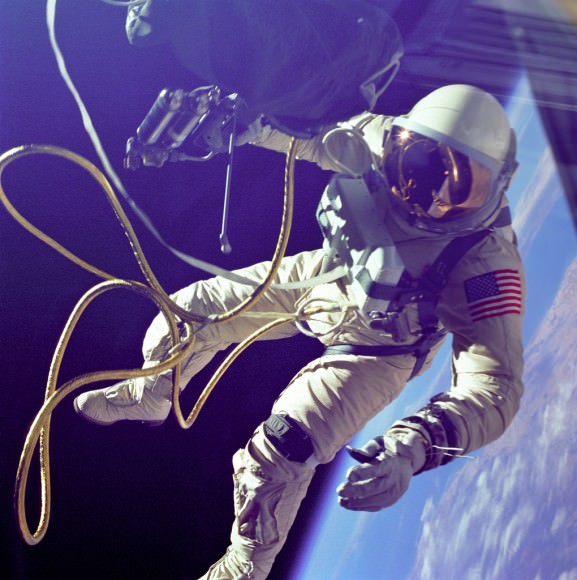
And number five, it’ll be fun. Humans need adventure. We need great challenges to push us to become the best versions of ourselves. We climb mountains because they’re there.
Ask anyone who’s built their own house or tried their hand at homesteading. It’s a tremendous amount of work, but it’s also rewarding in ways that buying stuff just isn’t.
The next time someone uses that argument on you, I hope this gives you some ammunition.
Phew, now I’ll get off my soapbox. Next week, I’m sure we’ll return to poop jokes, obscure science fiction references with a smattering of space science.
New Shepard Defies The Odds And Sticks Landing
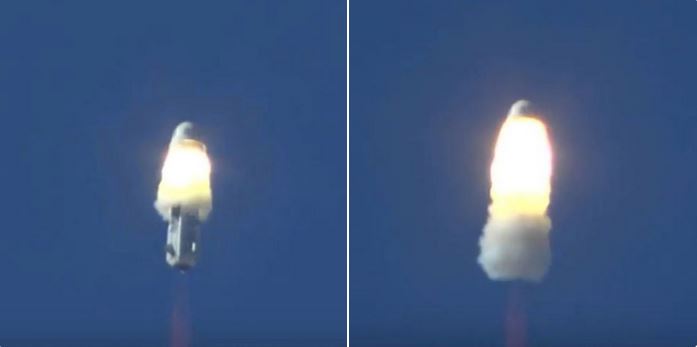
Blue Origin successfully conducted an in-flight test of the New Shepard crew escape system on Wednesday. A live webcast featured stunning views of the crew capsule blasting away from the rocket booster 45 seconds into the flight with a two-second burn, and then parachuting safely back down to the ground. “We’re speechless right now and absolutely rightfully so,” said launch commentator Ariane Cornell.
Adding to the excitement, the rocket booster unexpectedly also survived the test, returning intact and making a successful vertical landing back at Blue Origin’s West Texas facility. So, yes, we were wrong about it ending in ‘fiery destruction.’ Blue Origin founder Jeff Bezos had said computer simulations showed a minimal chance the booster could survive the stresses of “70,000 pounds of off-axis force delivered by searing hot exhaust,” from the capsule escape motor, and then successfully return and land vertically as it’s done previously.
Bezos was pumped about the outcome, tweeting “That is one hell of a booster,” and included this Vine video of the event:
This is the fifth launch and landing of this rocket, the fourth made just this year. The successful landing of the booster means the intact rocket will find a place of honor – perhaps in a museum or even as a lawn ornament at Blue Origin, as SpaceX did.
Here’s the webcast:
This is the fifth launch and landing of this rocket, the fourth made just this year. The successful landing of the booster means the intact rocket will find a place of honor – perhaps in a museum or even as a lawn ornament at Blue Origin, as SpaceX did.
The escape system is designed to safely separate the New Shepherd crew capsule from the rocket booster in the event of an anomaly during flight, protecting a future crew. The abort system performed as expected, as about 45 seconds after liftoff, the escape motor ignited underneath the crew capsule. The motor burned for two seconds and shot the capsule up and away from the rocket booster. After a bit of tumbling – which would have given any occupants inside a fairly wild ride –the capsule’s parachutes deployed, allowing it to land safely. It will be interesting to hear followup on the tumbling from Blue Origin’s engineers, to see how unexpected that might be.
Cornel said this was a nominal test, providing an “exhilarating but safe ride.”
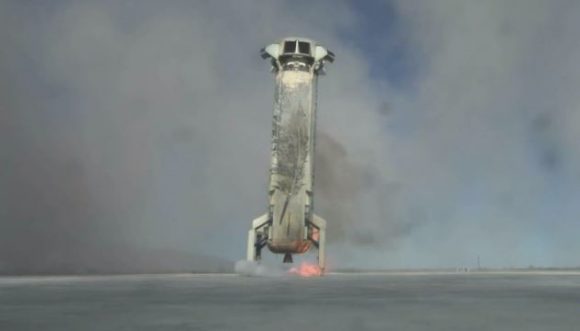
Once it was obvious the booster survived the blast from the escape system, it was fun and nail-biting to watch the booster reach the edge of space and then begin its descent. It used a series of braking maneuvers then just 8 minutes after launch as it approached the ground –still vertical — its BE-3 engine turned on and the landing legs deployed. The booster – looking only a little worse for wear — touched down gently.
Cornell said both the capsule and the booster will be retired, earning another turtle stencil.
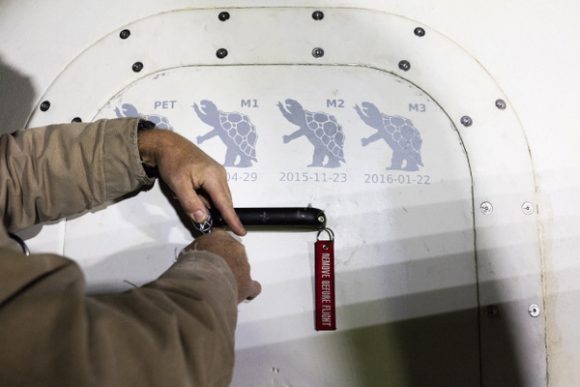
Blue Origin hopes to launch paying passengers into suborbital space by 2018 and today’s successful test means the company is on track to make it so.
Today’s successful test flight won praise from many in the industry. Eric Stallmer, presdient of the Commercial Spaceflight Federation congratulated the Blue Origin team and said, “Today’s fifth successful flight proved the New Shepard’s most critical safety features, innovative escape system technologies, and overall robustness of their system. It’s an exciting time to see these fantastic technological advancements and to witness the power of commercial industry.”
